Physical Address
304 North Cardinal St.
Dorchester Center, MA 02124
Over the past 30 years, globalization of the Internet and establishment of the smartphone as the dominant computing platform of our time have created enormous cultural shifts. The ability of an individual to instantly access personalized information and services has revolutionized nearly every sector of society including finance, transportation, media, entertainment, travel, and education ( Fig. 63.1 ). U.S. technology companies, now among the leading companies in the world, have provided the digital infrastructure and devices that have enabled this change. In 2019 Apple, Amazon, and Alphabet/Google had an estimated combined market capitalization valuation of $3.1 trillion dollars, which almost equals the annual U.S. National Healthcare Expenditure estimated at $3.6 trillion dollars. Health care is one of the last frontiers yet to offer the individualized services that digitalization enables. It is easier for consumers to understand and manage their financial portfolios than to view their own continuously collected heart rate data. For example, millions of patients with implantable cardiac rhythm management (CRM) devices are denied access to their devices’ information despite nearly 20 years of CRM device connectivity capability. Patients have demonstrated an appetite for their own personal health information as exemplified by the massive adoption of activity trackers and smartwatch-enabled health monitoring, but traditional health care has been largely hesitant to provide the tools and services that their patients can already easily and readily access in every other aspect of their lives.
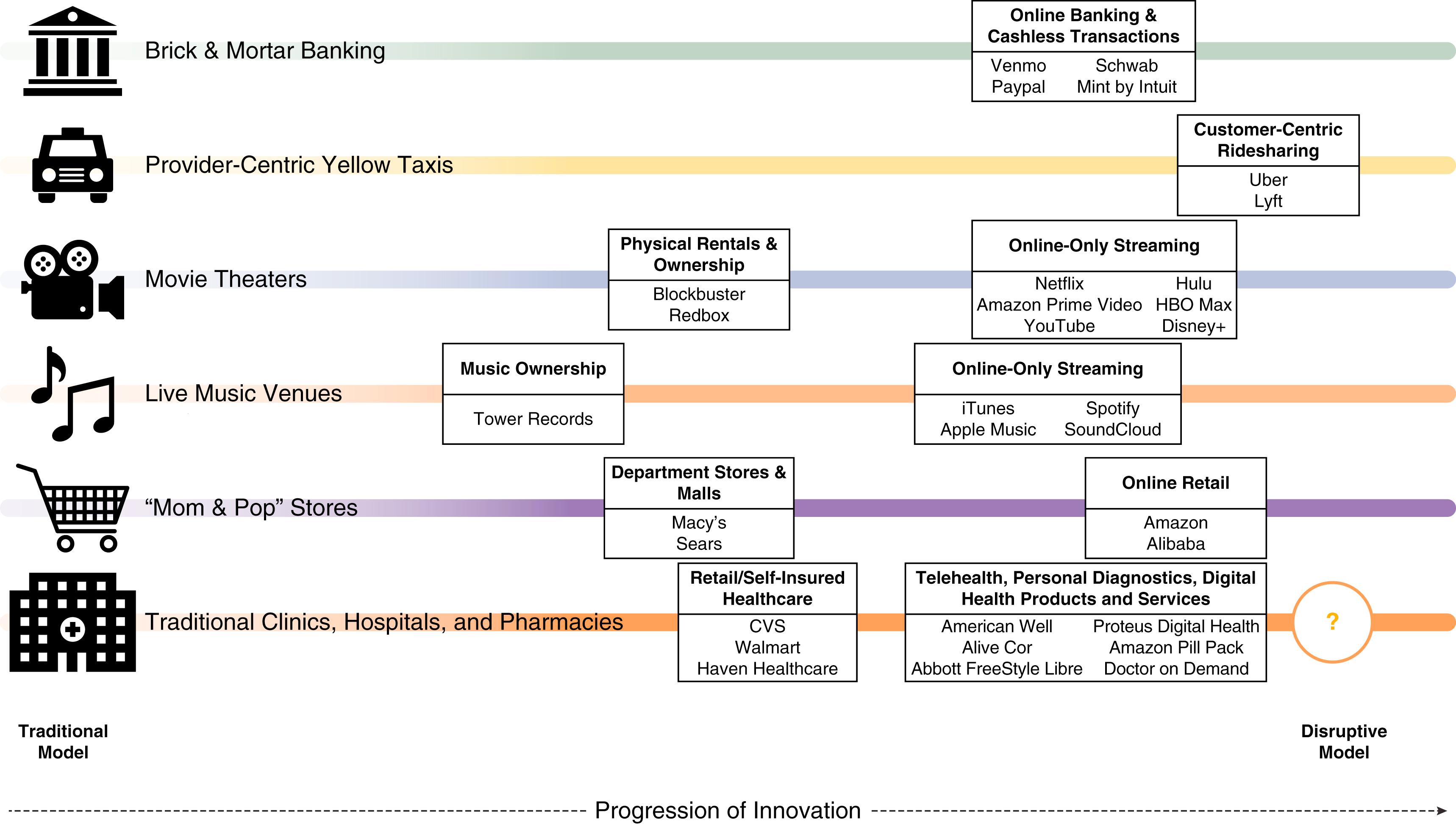
One of the major obstacles to the digitalization and personalization of medical tools and services is the entrenched culture of health care delivery that takes place in brick-and-mortar medical care facilities, and a lack of financial incentives for traditional health care delivery organizations to disrupt themselves to create patient-centered services. The brick-and-mortar model of health care delivery has not changed in the last century, despite a transformative shift in the way information is processed, analyzed, and shared across all other sectors. The reasons for this include the following: (1) full access to comprehensive medical knowledge has not been easily accessible, and thus historically has resided in the minds of medical experts who have limited availability; (2) patients are viewed by many medical professionals as unable to participate actively in their own diagnosis and care, resulting in a predominately patriarchal or paternalistic model of care , ; (3) patient data are collected and stored by individual health care entities who essentially silo and reproduce, digitally, a segregated versus integrated patient-centered medical record ; (4) electronic health care information transfer is subject to the Health Insurance Portability and Accountability Act (HIPAA), which is a protective set of national privacy and security rules that limit what information can be shared. For these reasons, health care has been slow to transform from inside leading to low levels of patient and provider satisfaction. Ideally, full integration of traditional health care data, in addition to integration with other data and services supporting an individual, would provide the individual consumer with more health care autonomy and lead to novel opportunities, services, and insights ( Fig. 63.2 ).
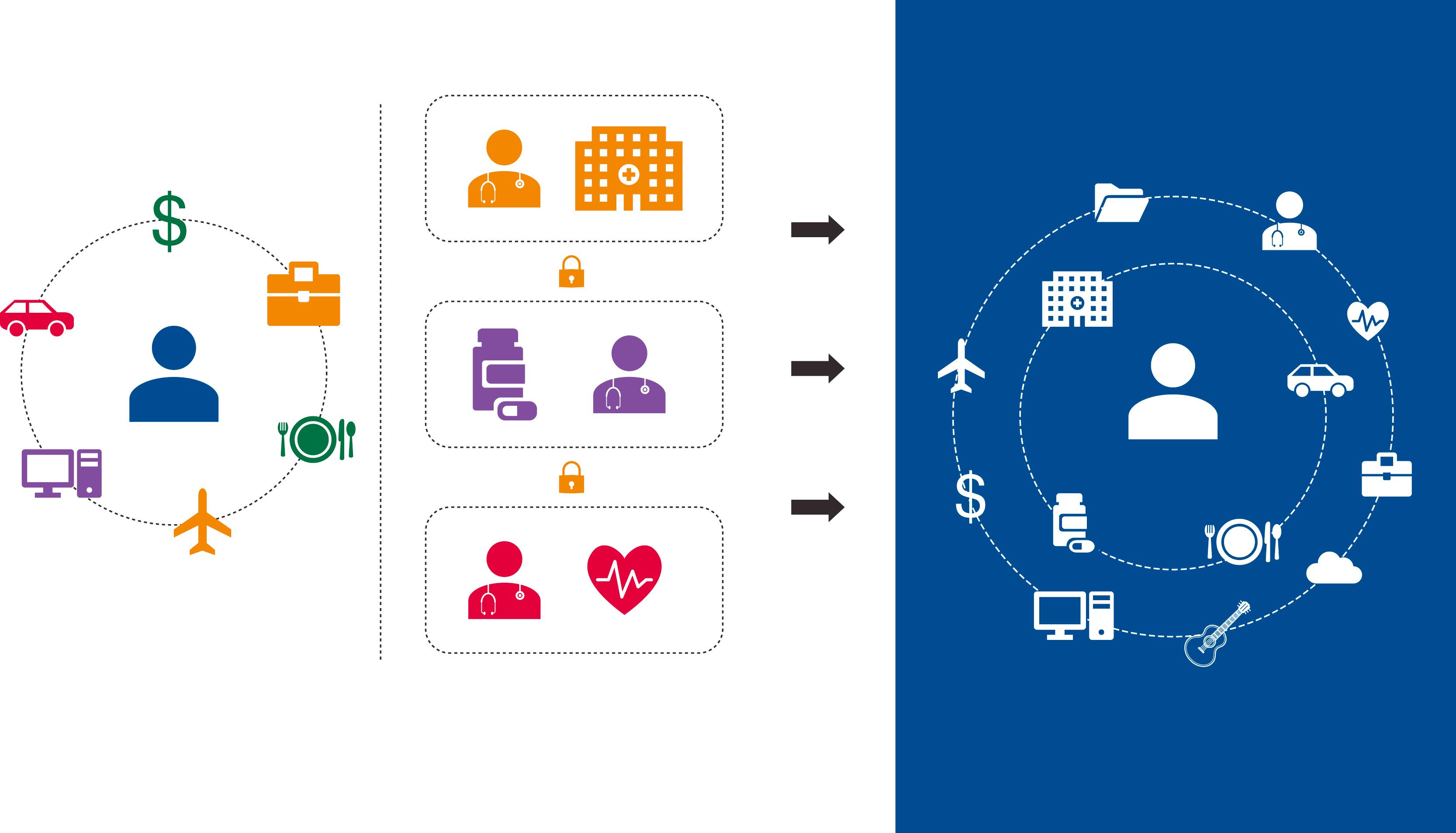
The places where people traditionally go for health care, the way it is paid for, and the way information flows worked wonders for the last century and accomplished great things. That era is being replaced by a more continuous model of health care—a model we call Life Care. Life Care is a model that takes into account the fact that patients spend more than 99% of their lives outside the care of their provider and further understands that choices they make on a daily basis including diet, exercise, sleep, and medical adherence significantly influence their health. Unlike traditional health care, Life Care leverages digital tools to continuously monitor the status of an individual outside of a medical facility while providing personalized, on-demand diagnostics and care to individuals in all states of health, including well, acute, and chronically ill patients. Sometimes, Life Care leads the individual to a traditional brick-and-mortar facility, but most of the time Life Care provides care virtually and is facilitated by software and services.
A key component of Life Care is personal cardiac monitoring (PCM). We define PCM as an individual’s ability to access and assess their heart’s function (i.e., electrical, mechanical) enabled by personalized technologies and services. In our view, access to PCM should not be controlled by medical experts. Devices like the AliveCor Kardia and Apple Watch are excellent examples of technologies that have achieved U.S. Food and Drug Administration (FDA) clearance for arrhythmia detection with direct consumer access. , Prior to the digital era and consumer-facing cardiac monitors, medical decisions such as indications for screening for atrial fibrillation (AF) were under the control of physicians and traditional medical payors. Now that PCM is becoming ubiquitous, these controls have much less meaning. We envision that in the Life Care health care delivery model of the future, PCM data will provide early index events for cardiac abnormalities that will lead to a cascade of events including risk stratification, medication prescription, personalized education, and collection of more continuous health data, and all before the patient first presents to a provider ( Fig. 63.3 ). Furthermore, PCM can provide important insights across a wide spectrum of individuals from patients with CRM devices to elite athletes and can become an essential component of monitoring disease status in chronic disease models such connective tissue diseases and diabetes. , In this time of great digital disruption, understanding how and when self-diagnosed individuals and their data interface with traditional medicine is complex, and it is the key to leveraging PCM for the betterment of medical care delivery and patient outcomes.
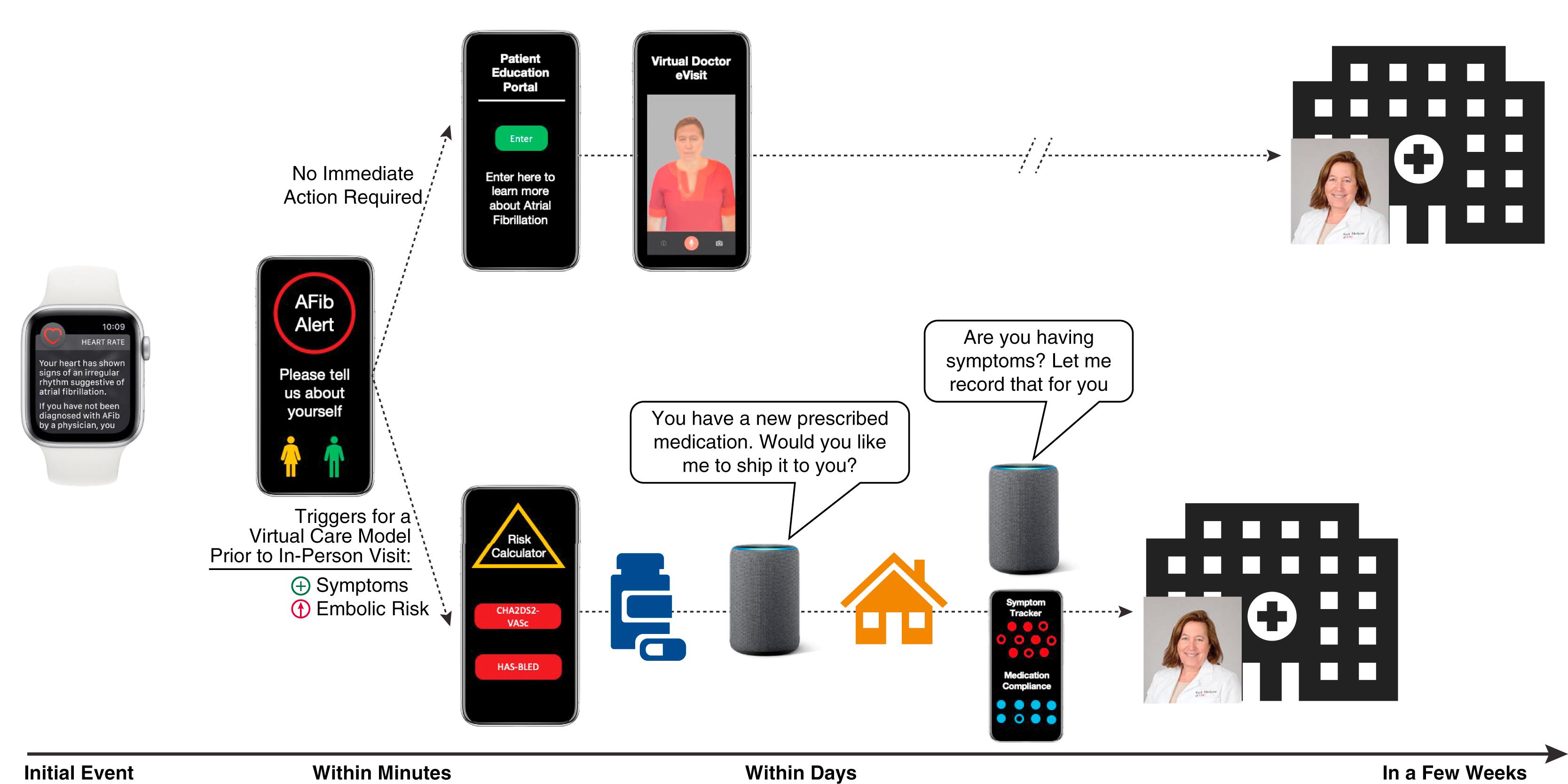
The giant technology companies of our time have turned their attention toward the health care field and are unburdened by the culture of traditional medicine, for good and bad. They see high levels of patient dissatisfaction, administrative inefficiencies, and antiquated usage of information and technology as a huge opportunity. The average American household owns 2.6 Apple products, roughly 9 in 10 shoppers will compare product prices on Amazon, and over 60% of all U.S. Internet search queries are hosted by Google. Alphabet/Google and Microsoft are using consumer data, artificial intelligence, and their cloud services to develop precision medicine virtual care models and to build novel and efficient clinical decision support tools that can analyze health data stored in traditional electronic health records (EHRs). Amazon recently acquired the online mail order pharmacy PillPack, instantly giving Amazon its own online pharmacy while also launching exclusive over-the-counter pharmaceuticals and diagnostic devices. Apple is leveraging its consumer products and privacy protections to assure the medical community that its devices and software provide secure tools for the collection and storage of medical data. They are also providing portals and services for traditional care patients to store their EHR on Apple devices to help the consumer track and manage their personally collected health data.
These companies have expanded the reach of PCM from patients with suspected or established heart disease to people of all ages and health statuses. This shift in thinking is revolutionizing the way people interact with their health data, creating unprecedented health literacy, and changing expectations of what health systems should be. In this chapter we will discuss the history of PCM, define cardiac monitoring as a digital biomarker, highlight current research in the field of PCM, discuss the challenges surrounding PCM, and envision a completely new and ubiquitous role for PCM. This chapter will highlight several companies and technology models that are currently enabling PCM, but it is by no means meant to be an inclusive review of all activity.
The first cardiac monitoring device can be traced back 200 years to the invention of the stethoscope by French physician Rene Laennec in 1816. For over 85 years, this elegant device was the predominant tool for assessment of cardiac function, rate, and rhythm. In 1902 electrocardiography (ECG) was invented and provided physicians with a direct way to visualize the electrical activity of the heart and an indirect means to assess health and disease states. In 1947, a physicist by the name of Norman “Jeff” Holter invented the first wearable ECG. He set out to record brain electroencephalograms but was faced with insurmountable signal-to-noise interference. However, as medical folklore goes, Holter had a stroke of genius and moved the electrodes from the head to the chest where electrical impulses were stronger. In doing so, Holter developed a wearable device and a method to record the electrical activity of the heart over time. For the next 60 years, the Holter monitoring was the gold standard for continuous patient cardiac monitoring despite being cumbersome to wear and allowing for only 24 to 48 hours of monitoring.
A new era in cardiac monitoring emerged with the invention of implantable CRM devices with built-in monitoring capabilities. These include pacemakers, implantable cardioverter defibrillators (ICDs), and loop recorders. By the late 1990s and early 2000s, many of these devices had remote monitoring capabilities, allowing clinics to detect rhythm abnormalities daily in their implanted device patients. In 2014 a wireless implantable pulmonary artery (PA) monitor (CardioMEMS, Abbott Cardiovascular) was approved by the FDA to remotely monitor PA pressures in ambulatory patients with advanced heart failure. Providers were now able to review PA pressures remotely, monitor patients on a daily basis, and provide timely medication intervention, well before symptom development. This information enables early, personally tailored treatments that are associated with better symptomatic and event-driven outcomes including fewer heart failure decompensations. However, these data are not directly accessible to the patient with the implant.
Ambulatory ECG monitoring was advanced at the turn of the 21st century, when a waterproof, single-lead adhesive patch (Zio Patch, iRhythm Technologies) was approved by the FDA. The small patch enabled monitoring intervals for up to 2 weeks without significant limitations on the patients daily activities. Despite improvements, such as added wireless connectivity and the ability to trigger the system, patients and their providers were not able to view recorded rhythms in real time.
Smartphone-enabled ECG recording was approved by the FDA for both prescriptive and consumer use in 2012, with the ECG smartphone case and subsequent stand-alone sensor manufactured by AliveCor. Although available to consumers, the device is a good example of how physician acceptance and engagement was critical to adoption and validation of the diagnostic algorithms that have had staged FDA approvals. This device allows users to capture and electronically transmit on-demand single-lead ECGs by touching electrodes attached to or near a smartphone. AliveCor has rate and rhythm detection capability and has added six-lead capability for expanded cardiac diagnostics and QT prolongation. The AliveCor devices are PCM devices that can be purchased by anyone, allowing consumers to engage in the management of their own health, while also having access to analytics and diagnostic algorithms. AliveCor has sold nearly one million devices to date, recorded approximately 65 million single-lead ECGs, and averages over 2 million 30-second ECGs records monthly. The average user is 63 years of age, and the majority of AliveCor devices are purchased on the recommendation of the user’s cardiologist.
In 2018, Apple introduced the fourth-generation Apple Watch (Series 4) with built-in on-demand, single-lead ECG recording capability and FDA-cleared algorithms for arrhythmia detection. The ECG recording is enabled by two dry electrodes found on the back of the watch and the watch crown. The Apple Watch records a 30-second ECG with PDF portability. Compared with the AliveCor device, this PCM-capable device is designed for the consumer and has a more evolved, software-enabled consumer experience. The ECG capability is offered as a feature on a connected device with many other functions (i.e., time, activity tracking, health tracking, phone and other app access). Unregulated features of the Series 1 to 4 watches include passive and on-demand heart rate access using the photoplethysmographic (PPG) features ( Fig. 63.4 ). In 2019 it is estimated that 30.7 million Apple Watches were sold worldwide. The Apple Watch PCM capability has the ability to scale to tens of millions of people globally, and gives an integrated health and Life Care experience without the need for fiscal or established cultural permissions from traditional health care.
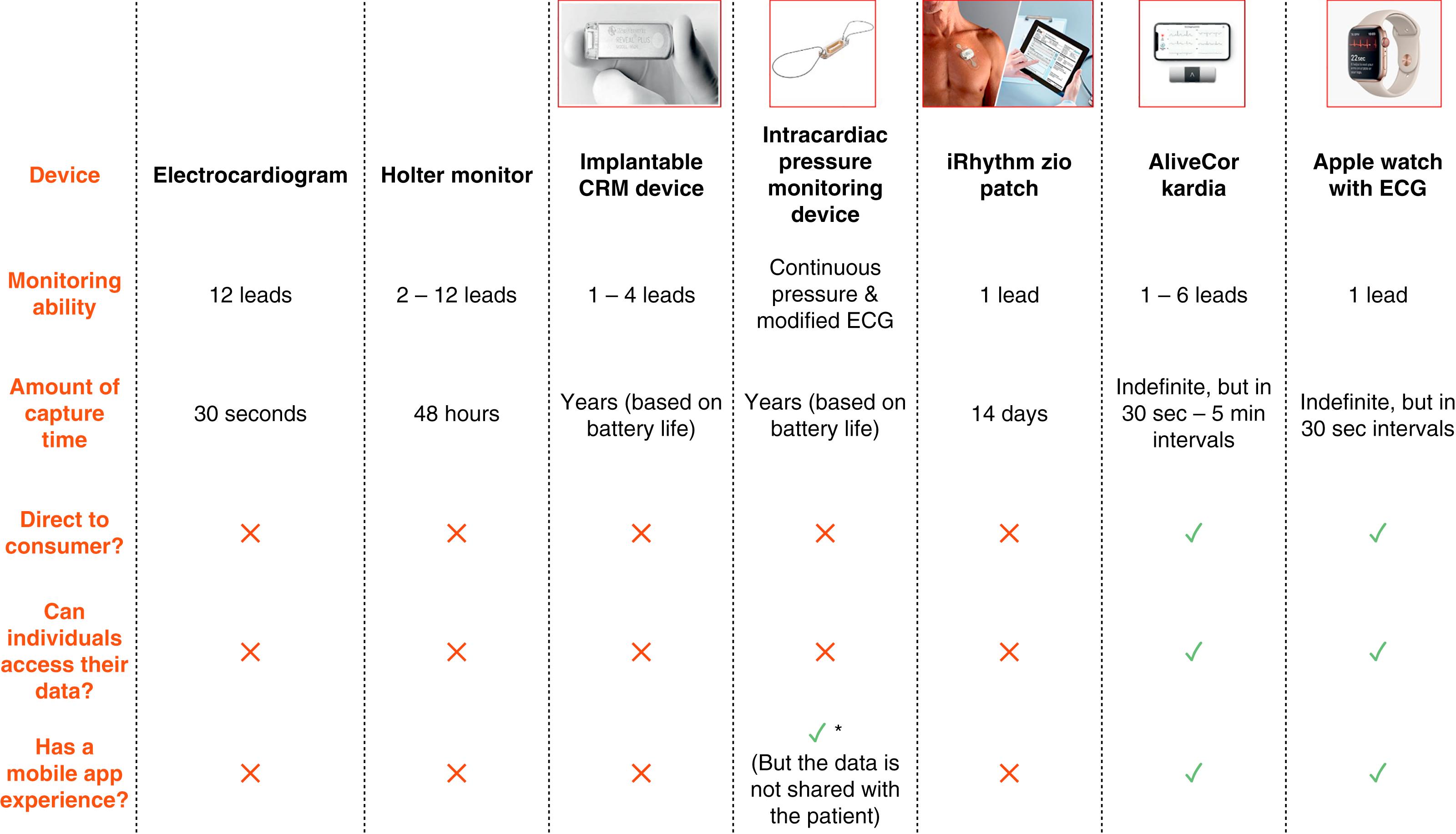
To facilitate medical research and consumer health tracking, Apple has developed three other enabling proprietary software kits: HealthKit, ResearchKit and CareKit. HealthKit allows health care and fitness apps to collate and extract data from the Health App, which serves as a data hub. ResearchKit is an open source framework designed for medical research and includes consent forms, survey formats, and validated active tasks using iPhone and watch sensors. CareKit provides a software framework to create apps that focus on tracking and managing medical care including features such as patient care plans, symptoms trackers, insight dashboards, and the ability to communicate with care teams and family members. The entire hardware and software stack enables the collection of massive amounts of continuous data both on an individual and population level while providing insights to the consumer and health care provider. This is an important step in our collective understanding as to how to better leverage the consumer to track and diagnose new health conditions in a continuous manner. In the same way that iTunes and Netflix charted a new course for music and entertainment consumption, these tools are a critical step in establishing new frontiers in health care tracking, education, and delivery.
Rapid advancements in technology have led to the creation of a myriad of wearable sensors that act as portals for the acquisition and rapid dissemination of physiologic data and are consequently changing the way we collect, analyze, and act on data. Implantable, wearable, external, and mobile devices can be integrated to acquire real-time data; perform near instantaneous calculations; and provide personalized, precise medical status updates. Remote PCM can result in great discovery and create a continuous model of benefit for patients and clinical management by moving care outside of traditional settings. This enables greater fidelity for identification of the first signs of abnormal cardiac behavior and characterizes the relationship between heart metrics and other conventional determinants of health and unconventional determinants of health such as geolocation data, computer keyboard interaction, and social network utilization.
Conventional cardiac health measures, such as heart rate and B-type natriuretic peptide (BNP), and these unconventional health factors, can be classified as biomarkers. FDA and the National Institutes of Health (NIH) task forces have worked to standardize the terminology surrounding biomarkers known as BEST (biomarkers, endpoints, and other tools) and to establish best clinical and research practices using biomarkers. They define the biomarker as “a defined characteristic that is measured as an indicator of normal biologic processes, pathogenic processes or responses to an exposure or intervention.” , Traditional medical biomarkers are often expensive, have limited use in the clinic, lack analytic complexity, and are restricted to short time periods. Digital biomarkers do not share these limitations and have become a new frontier in medicine. Digital biomarkers are defined as objective and quantifiable physiologic and behavioral data that are collected and measured through digital devices.
As adoption of FDA-approved and digital health solutions in traditional medicine grows, there is potential for unprecedented health data integration and identification of digital biomarkers that can favorably affect disease progression by providing earlier and novel biomarkers. Massive amounts of continuous and longitudinal data will be generated including digital medication tracking to measure adherence, continuous assessments of functional status, patient symptoms, and metabolic and fluid status. The ability to objectively measure human behavior digitally (termed digital phenotyping) is already affecting the fields of psychiatry and neurology, as discussed later in this chapter.
Physical activity and exercise tolerance are long known to be closely associated with cardiovascular health; yet, the current validated traditional biomarkers of exercise tolerance are derived from artificially created tests, such as the 6-minute walk test and cardiopulmonary exercise testing, which capture only snapshots of a health or disease state and need to be repeated to track disease progression. In the pediatric population in particular, there are significant physiologic and developmental limitations to these tests. Additionally, children may not exhibit the same physiology as adults, and this is important because many of the normative values have been developed in adult populations. At the USC Center for Body Computing, we are researching a pediatric-focused application called Heart Hero to identify more continuous and holistic digital biomarkers of cardiac functional status. Heart Hero incorporates gaming elements in which the user collects points by completing daily surveys and achieving walk goals to level up and unlock new characters. This custom-made research application leverages ResearchKit and HealthKit to measure daily behavioral status, symptoms, and Functional Class status and to collect continuous digital biomarkers including heart rate and physical activity via the Apple Watch. The collected measurements are indexed to baseline cardiopulmonary exercise tests results. We are analyzing the continuous data to identify a digital phenotype that can detect the earlier risk for clinical deterioration ( Fig. 63.5 ).
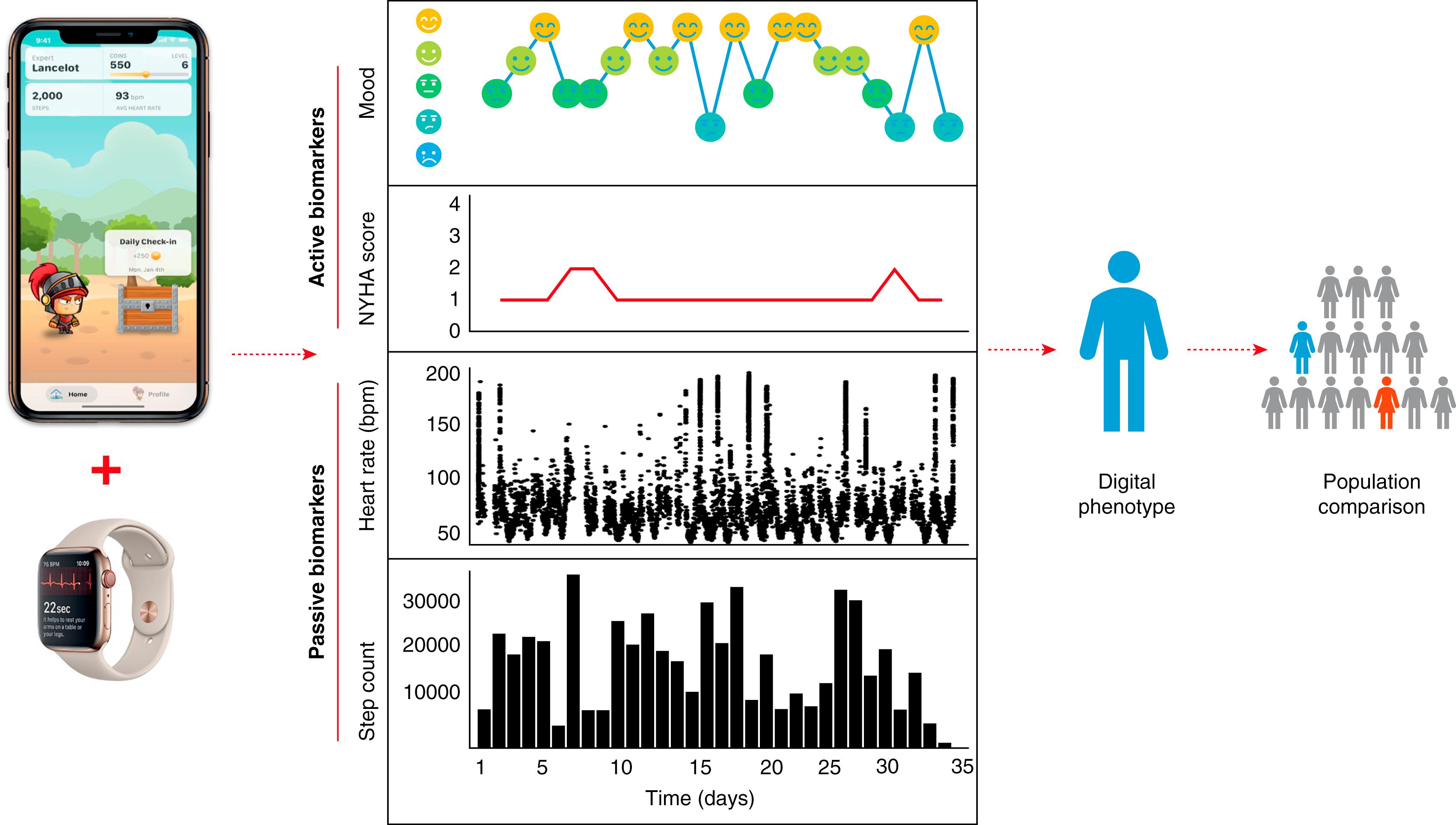
Become a Clinical Tree membership for Full access and enjoy Unlimited articles
If you are a member. Log in here